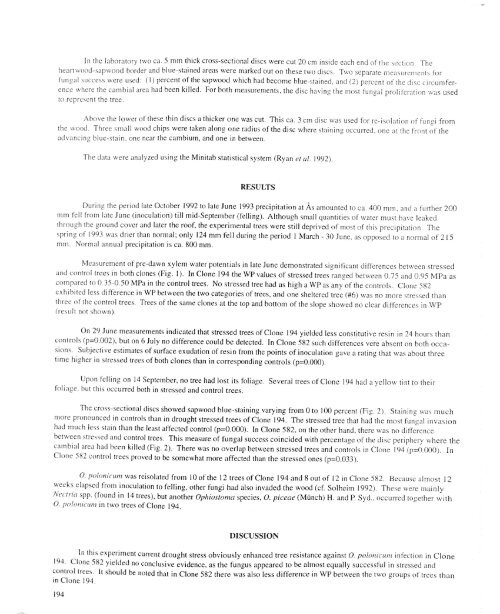View or print this publication - Northern Research Station - USDA ...
View or print this publication - Northern Research Station - USDA ...
View or print this publication - Northern Research Station - USDA ...
You also want an ePaper? Increase the reach of your titles
YUMPU automatically turns print PDFs into web optimized ePapers that Google loves.
in the lab<strong>or</strong>at<strong>or</strong>y two ca. 5 mm thick cross-sectional discs were cut 20 cm inside each end of the section. The<br />
he_._wo_>d-+sapwood b<strong>or</strong>der and blue-stained areas were marked out on these two discs. Two separate measuren_ents f<strong>or</strong><br />
fung_t sc_ccess were used: (I) percent of the sapwood which had become blue-stained, and (2) percent of the disc circurn ferer_ce<br />
where the cambial area had been killed. F<strong>or</strong> both measurements, the disc having the most ft._ngal proliferation was used<br />
t(_ represen_ the tree.<br />
Above the lower of these thin discs a thicker one was cut. This ca. 3 cm disc was used f<strong>or</strong> re-isolation of' fungi from<br />
Ihe wood. Three small wood chips were taken along one radius of the disc where staining occurred, one at the front of the<br />
advancing blue=s'tain, one near the carnbium, and one in between.<br />
The data were analyzed using the Minitab statistical system (Ryan et al. 1992).<br />
RESUUFS<br />
Dt.Jrin_4the period late October 1992 to late June 1993 precipitation at As amounted to ca. 400 ram, and a further 200<br />
mm f:cll fron_ late June (inoculation) till inid-September (felling). Although small quantities of water must have leaked<br />
{hrot_gh the ground cover and later the roof, the experimental trees were still deprived of most of <strong>this</strong> precipitation. The<br />
spring of 1993 was drier than n<strong>or</strong>mal; only 124 mm felt during the period 1 March - 30 June, as opposed to a n<strong>or</strong>mal of 2 t 5<br />
mm_ N<strong>or</strong>mal annual precipitation is ca. 800 ram.<br />
Measurement of pre-dawn xylem water potentials in late June demonstrated significant differences between stressed<br />
and control trees in both clones (Fig. 1). In Clone 194 the WP values of stressed trees ranged between 0.75 and 0.95 MPa as<br />
compared to 0.35..o0.50 MPa in the control trees. No stressed tree had as high a WP as any of the controls. Clone 582<br />
exhibited les_ difference in WP between the two categ<strong>or</strong>ies of trees, and one sheltered tree (#6) was no m<strong>or</strong>e stressed than<br />
three of the control trees. Trees of the same clones at the top and bott<strong>or</strong>n of the slope showed no clear differences in WP<br />
(rest_It nol shown).<br />
On 29 June measurements indicated that stressed trees of Clone 194 yielded less constitutive resin in 24 hours than<br />
controls (p=0.0()2), but on 6 July no difference could be detected. In Clone 582 such differences vere absent on both occa-<br />
sions. Subjective estimates of surfTxce exudation of resin from the points of inoculation gave a rating that was about three<br />
lime higher in stressed trees of both clones than in c<strong>or</strong>responding controls (p=0,0(X)).<br />
LIpon felling on 14 September, no tree had lost its foliage. Several trees of Clone 194 had a yellow tint to their<br />
fi_liage, but <strong>this</strong> occurred both in stressed and control trees.<br />
The cross-sectional discs showed sapwood blue-staining varying from 0 to 100 percent (Fig. 2). Staining was much<br />
m<strong>or</strong>e pronounced in controls than in drought stressed trees of Clone 194. The stressed tree that had the most fungal invasion<br />
had mucf_ tess s{ain than the least affected control (p=O.000). In Clone 582, on the other hand, there was no difference<br />
between stressed and control trees. This measure of fungal success coincided with percentage of the disc periphery where the<br />
cambial area had been killed (Fig, 2). There was no overlap between stressed trees and controls in Clone 194 (p=0.()0()). [n<br />
Chine 582 conm_t _rees proved to be somewhat m<strong>or</strong>e affected than the stressed ones (p=0.033).<br />
O. pol<strong>or</strong>uc_m was reisolated from 10 of the 12 trees of Clone 194 and 8 out of 12 in Clone 582. Because almost 12<br />
weeks elapsed from i_oculation to felling, other fungi had also invaded the wood (cf. Solheim 1992). These were mainly<br />
Nectria spp. (f:o_.md in 14 trees), but another Ophiostoma species, O. piceae (Mtinch) H. and R Syd., occurred together wiih<br />
O. I;,o!
















